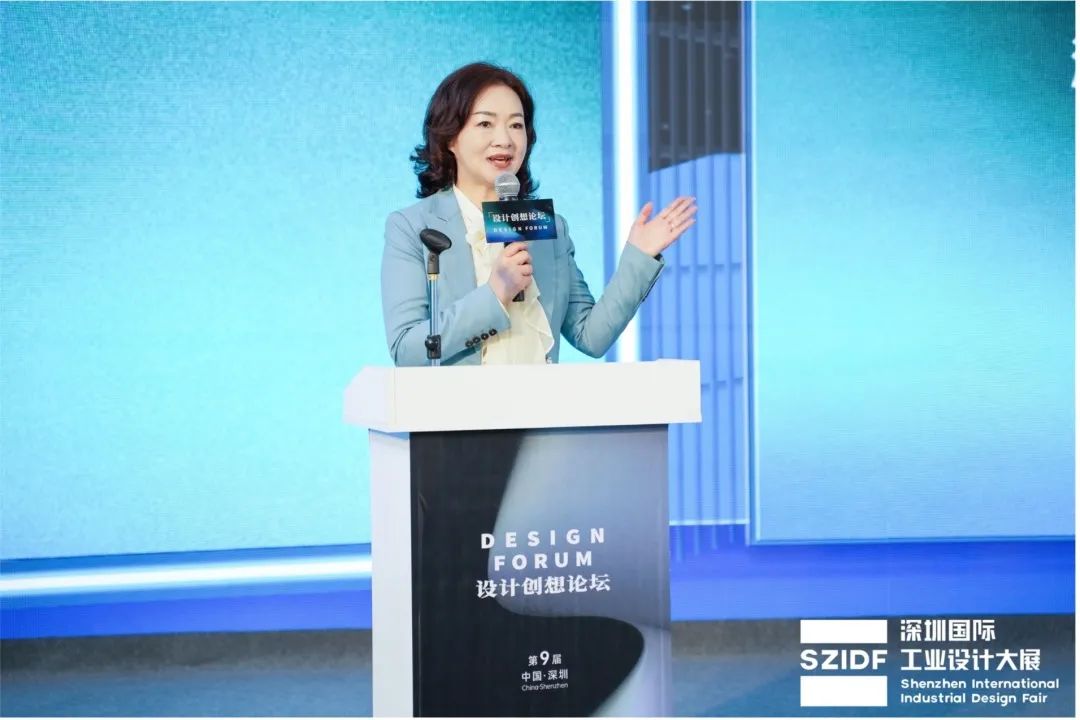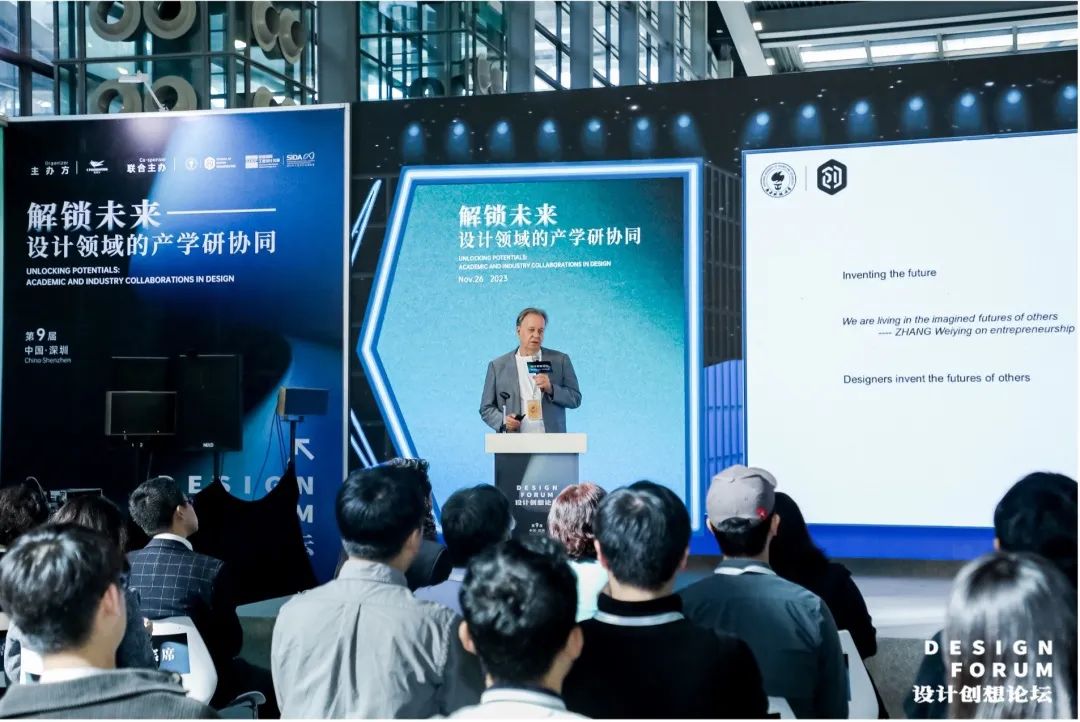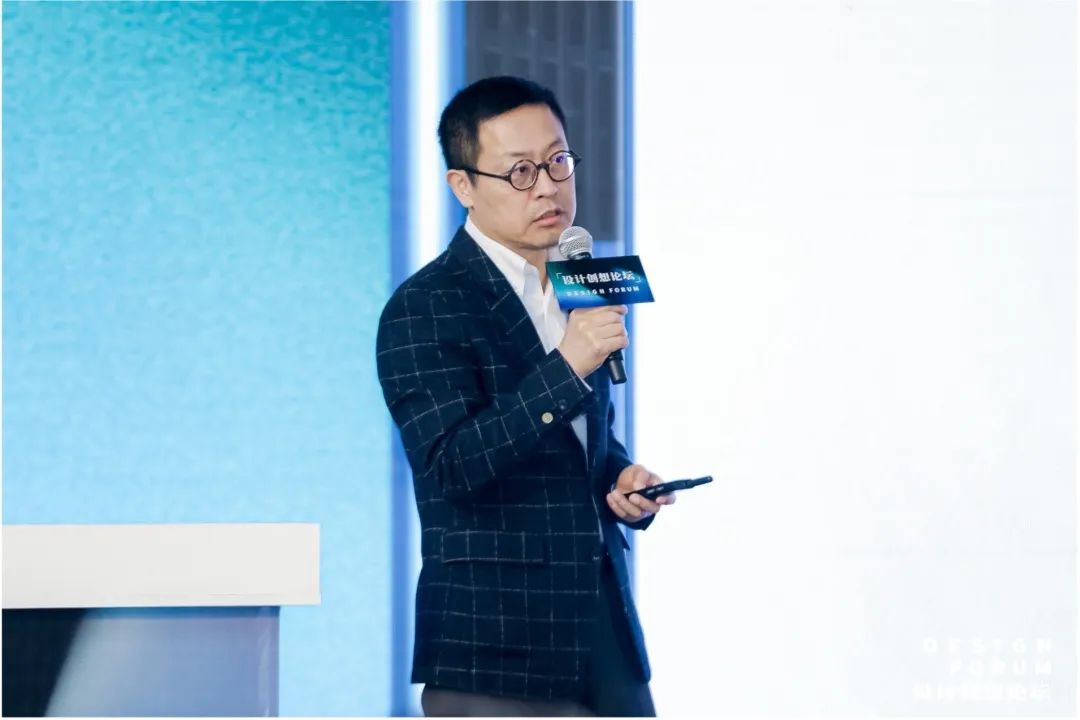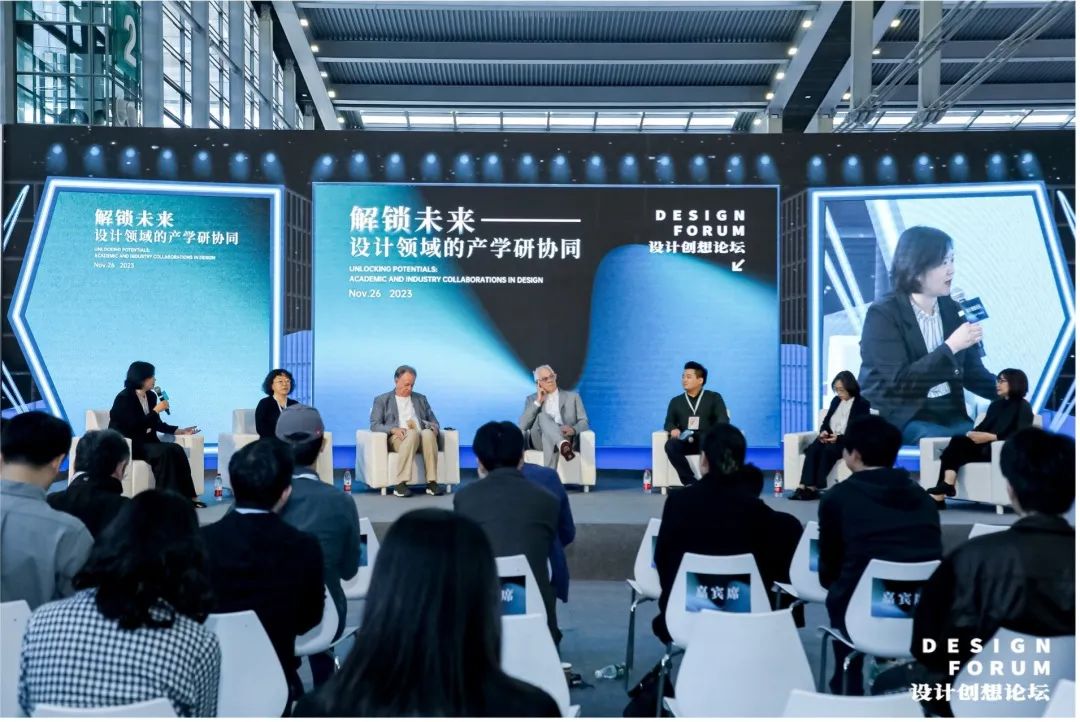Nov 29. 2023 - Latest News
On the morning of November 26, the 9th Design Innovation Forum, hosted by the Shenzhen Chuangxiang Public Welfare Foundation and co-hosted by the Shenzhen Industrial Design Profession Association (SIDA), the Shenzhen International Industrial Design Exhibition, and the School of Design, Southern University of Science and Technology (SUSTech) (hereinafter referred to as "SUSTech School of Design"), was successfully held at the Shenzhen Convention and Exhibition Center (Futian). With the theme of "Industry-University-Research Collaborative Innovation: Unlocking the Future of Design", this forum focused on industry-university-research cooperation in the design field and served as an integral part of the 2023 Shenzhen International Industrial Design Exhibition. On the same afternoon, the exhibition of the Institute's scientific research and teaching achievements also concluded at the Exhibition.
The theme of the forum closely aligned with that of the Exhibition – "Design Restarts · Symbiosis" – and explored how to unlock the infinite possibilities of design through industry-university-research collaborative innovation, as well as how to build a vibrant Shenzhen design education ecosystem.
Feng Changhong, President of the Shenzhen Industrial Design Profession Association (SIDA), delivered the opening speech. She extended a warm welcome to the guest speakers, educators, and designers in attendance, and shared her philosophy on design and vision for the future. Feng Changhong emphasized that "ideal" and "symbiosis" are two key words that designers and design educators should focus on. She stressed that design education should first and foremost cultivate people with ideals, aspirations, a sense of mission, and responsibility. Whether as designers or promoters of design, individuals must possess an eye for discovering beauty, a heart that loves life, and the courage to create infinite possibilities, while shouldering the responsibility of promoting the sustainable development of the planet with a strong sense of duty. In her speech, Feng also pointed out that "symbiosis" and "collaboration" are inherently connected. She expressed hope that the forum would conduct in-depth discussions on how to build a community with a shared future while maintaining a competitive spirit, and how to address the challenges posed by AI to the designer industry and even the human world – particularly by preserving inner emotions and other in-depth elements that cannot be replaced by technology.

Feng Changhong, President of the Shenzhen Industrial Design Profession Association (SIDA), delivering the opening speech
The Design Innovation Forum consisted of three parts. Professor Guan Daowen, Dean of SUSTech School of Design, and Professor Zhao Chao, Vice Dean of the Academy of Arts & Design, Tsinghua University, respectively delivered keynote speeches themed "Reflection Based on Practice" to kick off the discussions. Subsequently, hosted by Guan Daowen, a in-depth dialogue on "Pain Points and the Future of Industry-University-Research Collaboration in the Design Field" was held, with participants including Srini SRINIVASAN (Chief Operating Officer of Shanghai Institute of Design and Innovation), Zhao Chao, Li Xuanhong (General Manager of TCL Design Innovation Center), and Professor Sun Xiaohua (Distinguished Professor of SUSTech School of Design, to join soon). In the third part, a dialogue titled "Jointly Building a Design Education Ecosystem by Shenzhen Design Institutions" took place. The speakers included He Qinyang (Deputy Director of the Art Department, Shenzhen University), Liu Jun (Executive Director of the Cultural and Creative Products Research Institute, Shenzhen Polytechnic), Guan Daowen, Huo Yuda (Dean of the School of Creative Design, Shenzhen Technology University), Professor Roger Ball (School of Industrial Design, Georgia Institute of Technology), and Professor Shao Yu (Shenzhen International School of Design, Harbin Institute of Technology, Shenzhen). The entire forum was hosted by Li Xu, Administrative Vice Dean of SUSTech School of Design.
Professor Guan Daowen's report, titled "Design Education in Shenzhen", shared insights on establishing a design education model and curriculum system tailored to Shenzhen's characteristics. He emphasized that realizing the value of design requires joint efforts from the academic and industrial sectors to ensure that design advances in tandem with the development of society and the environment. When discussing the goals of design education, Guan stated that design is not only about solving current problems but also about envisioning and creating the future. Therefore, design education should cultivate designers with transformative creativity. He pointed out that cross-disciplinary support is crucial for excellent design, which requires integrating knowledge from science, technology, humanities, and business. To achieve this, it is necessary to shift from a "teacher-centered" instructional model to a "student-centered" active learning model. Based on an analysis of Shenzhen's economic and industrial features, he explained how academic institutions and industries have distinct yet complementary goals, needs, and advantages. Drawing on SUSTech's experience in running the school in Shenzhen, he advocated for closer collaboration between universities and industries to jointly cultivate design talents with foresight, perseverance, innovation, and entrepreneurial spirit.

Professor Guan Daowen, Dean of SUSTech School of Design, delivering the keynote speech
Professor Zhao Chao shared the rich experience and outstanding achievements of Tsinghua University and its Institute of Art and Technology Innovation in talent cultivation and industry-university-research collaborative innovation from three dimensions: platforms, sections, and projects. He highlighted the multiple definitions of design in today's technological society – from products, interactive experiences, and interfaces to end-to-end service integration – and noted the challenges posed to design schools by the interdisciplinary knowledge system of design. He pointed out that the goal of designers is to build a meaningful man-made world and define the significance of the humanistic world based on culture, technology, and user experience. At the end of his report, he proposed that design in the current era should pursue end-to-end innovation: from design innovation centered on business models at the front end, to platform innovation in the middle, and finally to experience-centered innovation. This, he emphasized, is a key consideration for industry-university-research collaboration.

Professor Zhao Chao, Vice Dean of the Academy of Arts & Design, Tsinghua University, delivering the keynote speech
In the first dialogue session, Srini SRINIVASAN, Zhao Chao, Li Xuanhong, and Sun Xiaohua engaged in a fascinating discussion. They shared their cutting-edge insights and valuable experiences, covering topics such as their personal experiences in industry-university-research cooperation, challenges encountered in collaboration, the balance between intellectual property protection and rapid technology transformation, and ethical issues potentially raised by the application of artificial intelligence in design.

On-site of the dialogue "Pain Points and the Future of Industry-University-Research Collaboration in the Design Field"
In the third part of the forum, representatives from six design schools/departments in Shenzhen – namely Shenzhen University, Southern University of Science and Technology, Shenzhen Polytechnic, Shenzhen Technology University, Georgia Tech Shenzhen Institute (Tsinghua University), and Shenzhen International School of Design (Harbin Institute of Technology, Shenzhen) – gathered for the first time. Centering on the theme of "Jointly Building a Design Education Ecosystem", they discussed how to foster a design education ecosystem characterized by pursuit of excellence, vitality, and diversified development in Shenzhen, a "City of Design", and the Greater Bay Area. The six representatives introduced the positioning and development of their respective institutions, as well as their unique features and advantages in discipline development and industry-university-research collaborative innovation. They also shared their unique contributions to the city, greatly enhancing the public's understanding of Shenzhen as a "City of Design" and its higher education in design. (For the wonderful content of the forum's reports and dialogues, please stay tuned for subsequent updates.)

On-site of the dialogue "Jointly Building a Design Education Ecosystem"
In conjunction with the forum, SUSTech School of Design showcased its key scientific research achievements and outstanding student works in the exhibition area of the Shenzhen International Industrial Design Exhibition. The exhibition comprehensively presented the research outcomes of the school's faculty, including vertical research projects, invention patents, published papers and monographs, cultural works, and exhibitions. It also displayed a series of "Industry + Design + Technology" research results developed by multiple teams composed of undergraduate, master's, and doctoral students under the guidance of teachers. The school aims to inspire industries through design research, promote the transformation of cutting-edge technology into future industrial applications, and drive inclusive innovation in technology through design.



On-site of the exhibition